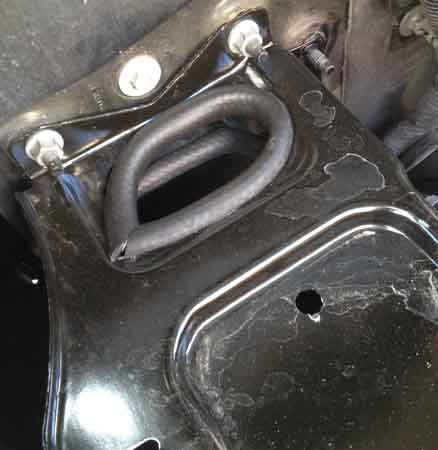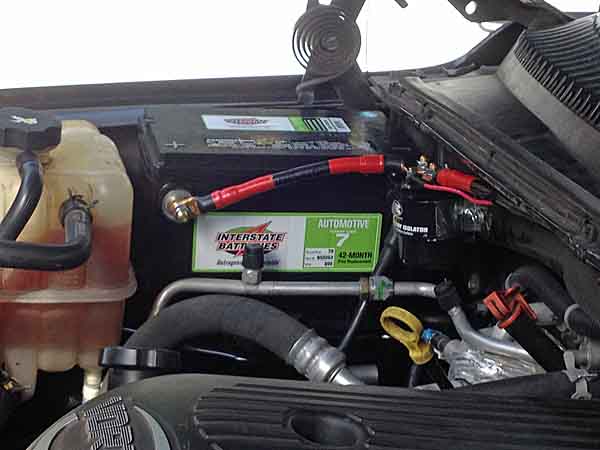Working on the front-facing end panel of the Power Module.
Most of the ~1500W inverters I'm looking at have built in cooling fans, but unfortunately they draw air in thru the plug outlet face and exhaust the warmer air out the opposite end. Which is inside the box. So that heat has to be encouraged to move along somewhere else. I'm messing around with adding a small 40-50mm DC computer fan and adding it among the array of power ports. But as I type this I realize I don't really need. The Inverter fan is doing the moving. All I need to is provide an opening or slots for the resulting overpressure to blow out.
But here's what I worked out. I did a quick run on the router table with a 45deg chamfering bit to increase the standard port size to meet the ID of the computer fan. I didn't do the math, but I believe the standard opening mouth has as much area as that of the fan, net (fan dia. minus its own hub dia). Then I put some black paint on things to pretty it up.
I could have opened the port size to match the bezel diameter of the other power adapters, for a better visual match, but didn't care to.
Then I spent some time with my mockup batteries, trying different layouts. As I look at the cargo sidewall some more, I realize that the likely cut-thru for the 1/0 power feeder is well forward of where I first thought. So as I'm envisioning the cable connections, the batteries would have to be more towards the rear or even spread apart in installation, with the cable connector passing between pairs of batteries. Or 3 on one side, 1 on the other. Four because they're cheaper that way -
https://www.amazon.com/dp/B00LRUGE0...UTF8&colid=QWZ1BSZYG6VW&coliid=I1HYG9HCU4E05B
I also did some other measuring to get an idea what is and isn't possible. The inch I had to take off the box is going to make things tougher. The way I'm going to have to route the 1/0 cables in the box is going to fill what remaining small gap there is between the small batteries and the box.
I've got about 4" of height over the batteries, I can double deck the solar charge controller arrangement later. Or even attach it to the box lid instead. I'm actually inclined to do that, anyway. Could even do the same with the fuze panel I'm considering. Still considering many layouts.
Shifting the batteries rearward is more trouble, really encroaching on the space needed for a 1500w-class inverter.
I could try running all the batteries end to end along the hinge side of the Module. With just a gap where the 1/0 cable connector has to pass thru. I think they might fit that way and that give me more room down the off-side of the box for fuse panels, marine rotary switch, bus bars etc.
The batteries are an 'option'. Ideally I'd like to cram as much in there as possible. They're 10.5Ah apiece. So four of them is almost as much runtime as a standard automotive battery, which I can't fit in my layout. If I can only fit a couple, that's ok. Still working out how to both integrate and isolate them, in various operating conditions.
And speaking of operating conditions, I also staged a couple photos related to mobile HAM, but this would go for just about any other electronic device. Radios, phones, laptops, lighting, re-charging just about anything.
I have a small bag I use as a handheld HAM radio kit bag. In it are a variety of power and recharging options. The only thing I'm lacking is a radio battery pack that uses AA batts. I also have a wallet-sized folding solar panel that recharges AA Eneloop batteries and will recharge USB-connected devices. That panel stays in my BugoutBag / Day Hike bag. Which now rides in the right-hand drawer of my storage platform setup.
Anyway, here's a few pics of the options.
All that stuff could be run out of a single 12v cigarette lighter / PowerPort, and with the battery clamps, right off any 12v battery.
But I want(ed) to be able to support the power needs of multiple people, simultaneously if necessary. Hunting camp, search party, post disaster (lost my home to the '94 Northridge quake, caught totally flatfooted, zero preparedness), anything.
My prior Marine service background working in and operating an Artillery Battalion CP and mobile command teams working out of upgraded Humvees is no small part of what drives and informs the projects I'm undertaking for this Suburban. That goes for my other build projects as well, roof deck / back boards, awnings, and more projects to come. I want this vehicle to be able to serve as a hub for, well, anything.
And it is part of why I'm not appreciating people taking the piss with me about 'too complicated' design.


































